“], “filter”: { “nextExceptions”: “img, blockquote, div”, “nextContainsExceptions”: “img, blockquote, a.btn, a.o-button”} }”>
Heading out the door? Read this article on the new Outside+ app available now on iOS devices for members!
>”,”name”:”in-content-cta”,”type”:”link”}}”>Download the app.
It’s easy to assume that yoga is beneficial only if you practice for extended amounts of time. hour of focused time on the mat. But the reality is that many of us have limited time for extended yoga workouts. But something strength training on a busy day Having an efficient at-home yoga strength training workout can be a perfect option on these busy days when you can’t do traditional strength training.ta students of yoga as well as those who are new to the practice to
As a certified personal trainer and yoga instructor, I, too, fall into the camp of needing a quick full-body strength workout when my schedule is hectic. So do my clients. The following yoga strengthening exercises are what I rely on.
I don’t recommend always trying to blast through your yoga workouts or prioritizing efficiency. But you may find that rely on on a full-body yoga strength training workout as an option rather than skipping a workout you’re short on time or don’t have access to the gym.
7 Yoga Poses for a Full-Body Strength Workout You Can Do Anywhere
Following are the most efficient yoga poses for an at-home full-body yoga strengthening workout. Stay in each yoga pose for 30 to 60 seconds. On days when you have time, work up to 2 or 3 sets of each strengthening yoga pose.
Warm-Up
Even when you’re short on time, you need to include a brief warm-up. If you practice yoga, you probably already have some preferred warm-up stretches.
If you practice gym-based strength-training exercises, try alternating forward and reverse lunges. Perform 30 seconds of forward lunges with your right leg followed by 30 seconds of reverse lunges with your right leg. Repeat on your left side. Then practice 30 seconds of trunk twists, starting small and gradually increasing your range of motion.
1. Warrior 2 Pose (Virabhadrasana II)
Warrior poses are helpful yoga strengthening exercises because they not only challenge the quads and glutes but also your core muscles, which help maintain your balance.
Start with practicing Warrior 2 for 30 seconds and then either switch sides or immediately transition into Warrior 3 before practicing both poses on the other side.
Practice Warrior 2 Pose
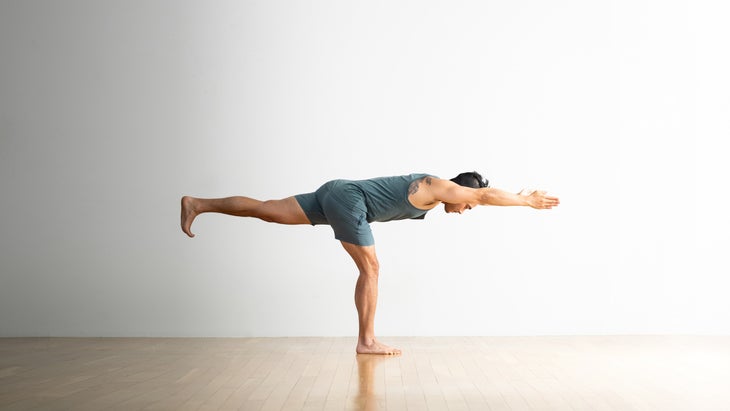
2. Warrior 3 (Virabhadrasana III)
Warrior 3 is one of the best yoga poses for building glute strength. It also works the quads and core as well as the upper back, making it a full-body strengthening pose. To ensure you’re actively engaging your core, push through your lifted heel. This also helps maintain your balance.
From Warrior 2 or a standing position, bring your hands together at your chest and shift your weight forward into your front leg. Reaching your arms alongside your ears amplifies the demand on your core muscles.
Practice Warrior 3
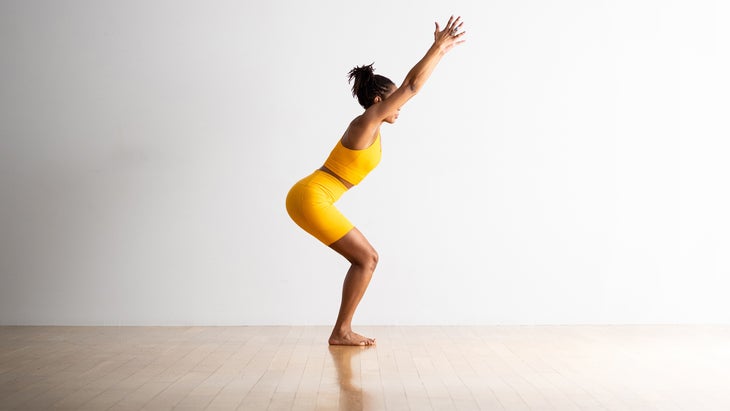
3. Chair or One-Legged Chair Pose (Eka Pada Utkatasana)
I prefer the single-leg variation of Chair Pose, in which you hover one leg above the mat, as part of a full-body yoga workout. It’s basically like holding a single-leg squat, which means your lower body muscles on one leg have to support your entire body, which results in more resistance than the traditional version of the pose.
Plus, the small base of support challenges your balance, which actively engages your core muscles as well as the smaller muscles in the hips and ankles. But even if you opt for the traditional Chair Pose, you’ll still build quad and core strength.
After your Warrior sequence, move into Chair Pose and lift one leg as you balance for 30 seconds. Then lower it and lift the other leg.
Practice Chair Pose
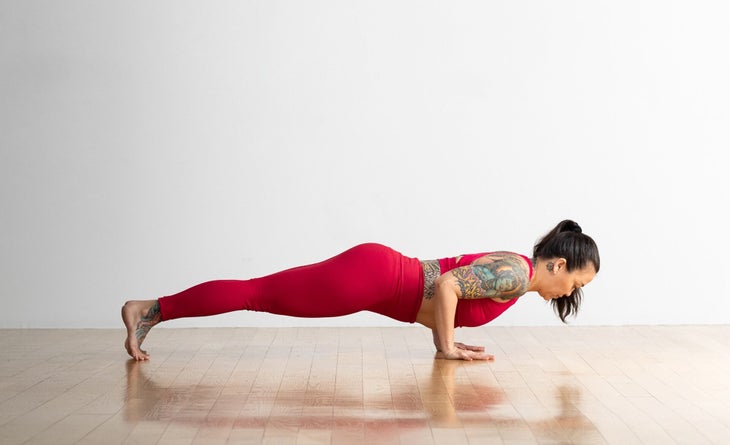
4. Four-Limbed Staff Pose (Chaturanga Dandasana)
Anyone coming to yoga from an athletic or strength-training background knows that Plank, or High Push Up, is an essential strengthening exercise for your core and shoulder muscles. Bending your elbows and lowering yourself partly toward the mat in Chaturanga, sometimes known as Low Plank, amplifies that challenge.
Focus your attention on squeezing your glutes to prevent your hips from sagging and reduce the strain on your lower back. Also, harness the stabilizing muscles along your spine by pushing through your heels as if you’re reaching toward the wall behind you.
Practice Chaturanga

5. Locust (Salabhasana)
This seemingly subtle but intense backbend strengthens your glutes, upper back muscles, and shoulders while also stretching the pectoralis muscles across your chest. Unlike more dramatic backbends, which use gravity or holding onto your ankles with your hands to create the shape, Cobra demands your lower back muscles contract to lift your body off the mat. Focus on squeezing your glutes.
If you’re new to this yoga strengthening exercise, lift just your upper body from the mat. Then try a second rep in which you lift just your lower body. Eventually work up to lifting both at once.
Practice Locust Pose
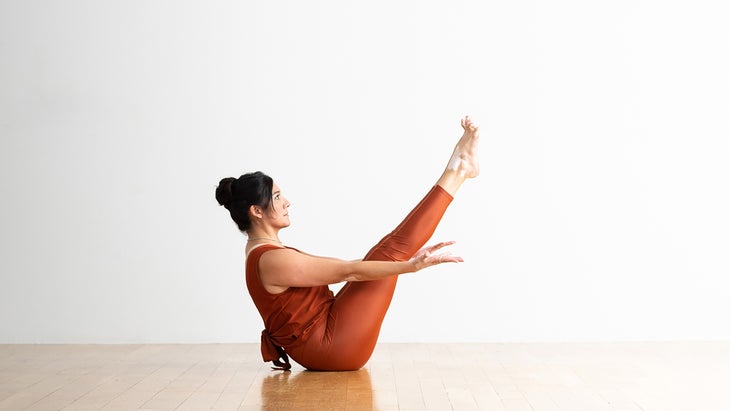
6. Boat Pose (Paripurna Navasana)
One of the best-known (some may say infamous) yoga poses for core strength, Boat Pose is basically a V-Sit Hold. It strengthens your entire core, including not just your superficial abdominal muscles but the deep transversus abdominis and iliopsoas as well as your quads, hip flexors, and spinal stabilizers.
Keep your back straight by engaging your lower abdominal muscles and drawing your shoulders back to engage the upper back muscles, which are notoriously weak in most of us. If you point your toes, you’ll also stretch the often-overlooked muscles along your shins.
Practice Boat Pose
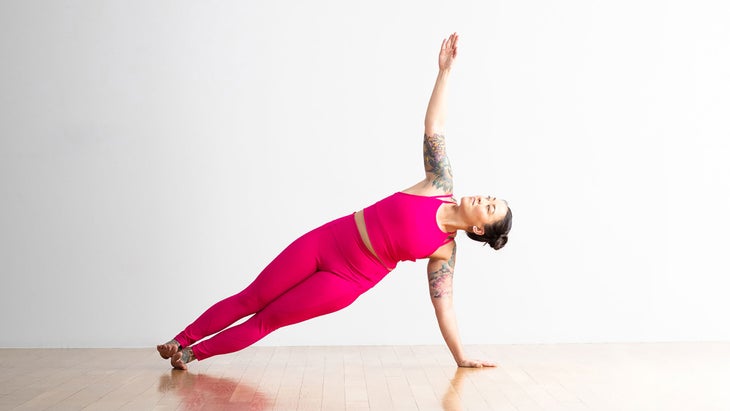
7. Side Plank Pose (Vasisthasana)
I always include this core-strengthener pose in any full-body workout because it challenges the core, hip, and shoulder muscles in a different relationship to gravity than usual. This forces the muscles of the core and pelvic girdle to work in 360-degree fashion to hold you steady as you balance. Forgetting to build lateral strength and stability can lead to muscular imbalances and functional weakness.
Practice Side Plank Pose
Cool Down
After completing 2-3 sets of the strengthening yoga poses in your full-body strength workout, cool down by practicing Downward-Facing Dog for 30 to 60 seconds. Then lower your knees and hips to the mat and lift yourself into Sphinx Pose and linger here for 30 to 60 seconds as you slow your breath let your weight sink into the mat. Sink your hips back into Child’s Pose or settle into Savasana before continuing with your day.












